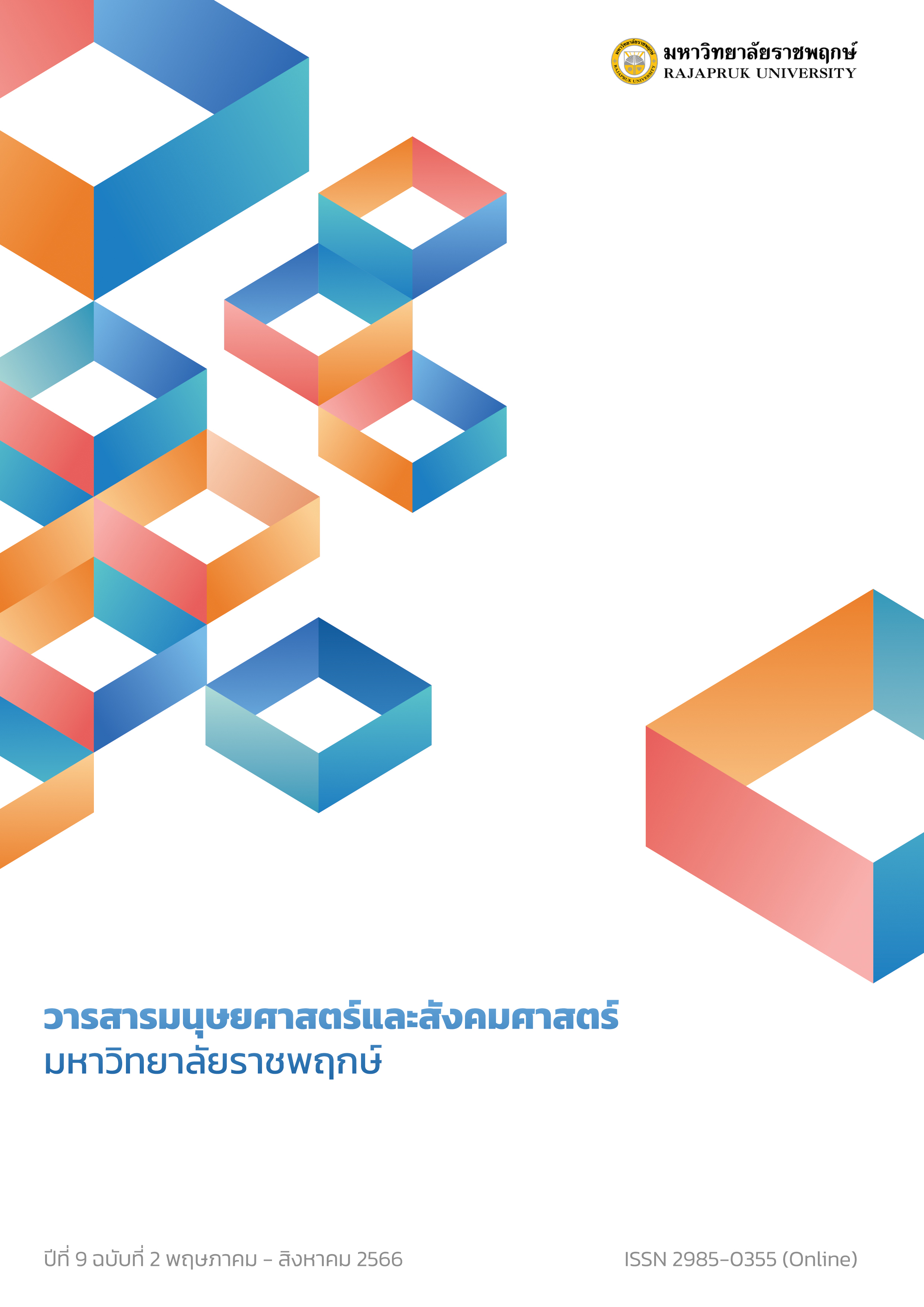Work-Life Balance of Generation Y employees in Nonthaburi Province
Main Article Content
Abstract
The purposes of this research were to 1) study the Work-Life Balance level of organization members towards to Generation Y Employees in Nonthaburi Province, and 2) compare the Work-Life Balance of organization members toward to generation Y employees in Nonthaburi Province. The sample group in this study was 384 Generation Y Employees who work in Nonthaburi. Data analysis using statistics, frequency, percentage, mean, standard deviation. Work-life balance was compared using t-test, One-way ANOVA method, and pairwise comparisons were performed using Scheffé at the statistical significance level .05. The statistical data analysis was performed which were frequency, percentage, mean, and standard deviation. The comparison of the Work-Life Balance of organization members was performed by t-test, One-way ANOVA and comparison by the method of significant difference Scheffé’s at .05 significant level.
The results of the research revealed that 1) the respondents had a balance between life and work of Generation Y employees in Nonthaburi Province. Overall and side and 2) a comparative study of Work-Life Balance of Generation Y employees in Nonthaburi Province. Education level average monthly income, occupation, and travel time are different. There is a balance between life and work. Overall, there is no difference. But Generation Y employees with different job titles, working hours and working hours have different work-life balance. Overall, the difference was statistically significant at the .05 level.
Article Details
References
โครงการสุขภาพคนไทย. (2559). 12 ตัวชี้วัด สุขภาพคนไทยต่างเจเนอเรชัน. นครปฐม: สถาบันวิจัยประชากรและสังคม มหาวิทยาลัยมหิดล. 14-15.
ฉัตรภรณ์ กาทองท่ง. (2560). สภาพแวดล้อมการทำงานและความสมดุลระหว่างชีวิตกับการทำงานที่มีอิทธิพลต่อคุณภาพชีวิตการทำงานของพนักงานบริษัทก่อสร้าง. การศึกษาค้นคว้าแบบอิสระ บริหารธุรกิจมหาบัณฑิต มหาวิทยาลัยเทคโนโลยีราชมงคลธัญบุรี.
ณพัชญ์ปภา สว่างนุวัตรกุล. (2562). ความผูกพันต่อองค์การจากมุมมองบุคลากรทางการศึกษาเจเนอเรชันวาย. วารสารช่อพะยอม. 30(2): 109-118.
ดาวใจ ศรลัมพ์. (2555). การศึกษาเปรียบเทียบปัจจัยที่มีอิทธิพลต่อความรัก ความมุ่งมั่น และความปรารถนาที่จะทำงานเพื่อองค์การอย่างเต็มความสามารถของบุคลากร 3 ช่วงวัย: กรณีศึกษาบริษัท ปูนซีเมนต์ไทย (แก่งคอย) จำกัด. วิทยานิพนธ์ ปริญญามหาบัณฑิต สถาบันบัณฑิตพัฒนาบริหารศาสตร์.
ปริณดา สมควร. (2557). ความสมดุลระหว่างชีวิตและการทำงานกับประสิทธิผลการปฏิบัติงานของขาราชการตำรวจกองบังคับการอำนวยการ สำนักงานตรวจคนเขาเมือง. สารนิพนธ์ รัฐประศาสนศาสตรมหาบัณฑิต มหาวิทยาลัยเกริก.
ปัทมาพร ท่อชู. (2559). การพัฒนาประสิทธิภาพการทำงาน (The Efficiency Development of Operation). วารสาร Industrial technology review, 22(282): 94-100.
ภาวิณี แสนวัน. (2557). การศึกษาปัจจัยด้านส่วนบุคคล ปัจจัยด้านการทำงาน และปัจจัยด้านสังคมที่มีผลต่อความสมดุล ระหว่างชีวิตและการทำงานของพนักงานในเขตกรุงเทพมหานคร. การค้นคว้าอิสระ บริหารธุรกิจมหาบัณฑิต มหาวิทยาลัยกรุงเทพ.
วรัญญา ดุษดี พวงเพ็ชร์ วัชรอยู่ และ อภิญญา หิรัญวงษ์ (2560) ผลกระทบของความผาสุกของพนักงาน ความสมดุลระหว่างชีวิตกับการทำงาน และวัฒนธรรมองค์การที่มีต่อความผูกพันของพนักงานต่อองค์การของธุรกิจตัวแทนจำหน่ายรถยนต์. วารสารบริหารธุรกิจเทคโนโลยีมหานคร มหาวิทยาลัยเทคโนโลยีมหานคร, 14 (1): 178-197.
วิทยา อินทร์สอน และ สุรพงศ์ บางพาน. (2563). แนวทางการพัฒนาคุณภาพชีวิต ในการทำงานของพนักงานโรงงานอุตสาหกรรม. ค้นเมื่อวันที่ 30 พฤษภาคม 2563, จาก http://www.thailandindustry.com/onlinemag/view2 .php?id =773 §ion =30&issues =74.
วิวสกิล. (2560). ในสังคมทำงานยุคนี้ กำลังเจอกับปัญหาใหญ่ เพราะ คน Gen Y?. ค้นเมื่อวันที่ 30 พฤษภาคม 2563, จาก http://willskills.info.
ศุภลักษณ์ แลปรุรัตน์. (2557). ความสัมพันธ์ระหว่างความพึงพอใจในการทำงานและความตั้งใจลาออก: การศึกษาในพนักงานเจเนอเรชันวายของธนาคารพาณิชย์ในจังหวัดขอนแก่นประเทศไทย. วิทยานิพนธ์ บริหารธุรกิจมหาบัณฑิต มหาวิทยาลัยขอนแก่น.
สัมฤทธิ์ กางเพ็ง และ สรายุทธ กันหลง. (2560). การวิจัยแบบผสมวิธี: กระบวนทัศน์การวิจัยในศตวรรษที่ 21. พิมพ์ครั้งที่ 3. มหาสารคาม: อภิชาติการพิมพ์.
สำนักบริหารการทะเบียนกรมการปกครอง. (2563). ระบบสถิติทางการทะเบียน จำนวนประชากรแยกตามรายอายุ จังหวัดนนทบุรี พ.ศ.2563. ค้นเมื่อวันที่ 31 ตุลาคม 2563, จาก https://stat.bora.dopa.go.th/stat/statnew/statMenu/newStat/home.php.
เอสซีบี เอสเอ็มอี. (2561). 4 หนทางหยุดการลาออกของเด็ก Gen Y. ค้นเมื่อวันที่ 30 พฤษภาคม 2563, จาก https://businesslinx.globallinker.com/bizforum/article.
Bailey, K.D. (1987). Methods of Social Research. 3rd ed. London: Collin Macmillan Publisher.
Bond, S. and Wise, S. (2003). Work-life policy: does it do exactly what it says on the tin?. Women in Management Review, 18(1/2): 20-31.
Cochran, W.G. (1977) . Sampling Techniques. 3rd ed. New York: John Wiley and Sons Inc.
Mannheim, K. (1952). The Problem of Generations, Essays on the Sociology of Knowledge. Retrieved from http://www.history.ucsb.edu/faculty/marcuse/ classes/201/articles/27MannheimGenerations.pdf.
Merrill, A.R. and Merrill, R.R.. (2003). Life Matter: Crating a dynamic balance of work, family, Time and money. New York: McGraw-Hall.
Walton, R. E. (1973). Quality of work life. Sloan Management Review, 15(1): 11-12.


